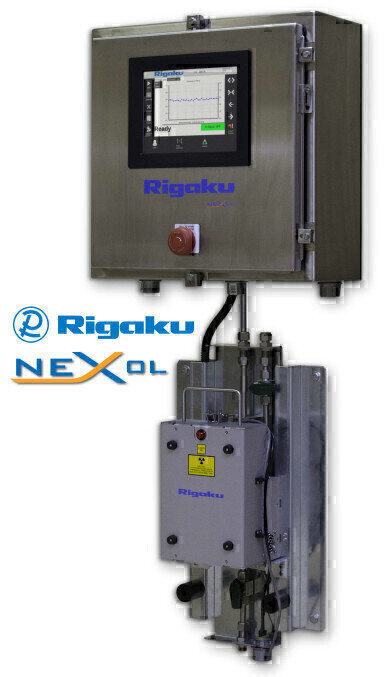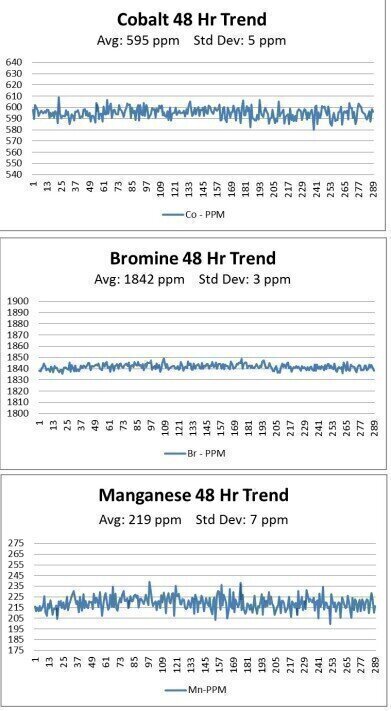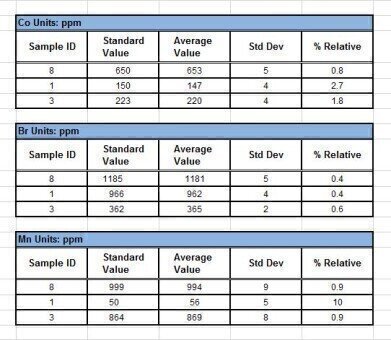Analytical Instrumentation
On-line measurement of cobalt (Co), bromine (Br) and manganese (Mn) in terephthalic acid (TPA)
Mar 20 2019
Scope
On-line measurement of cobalt (Co), bromine (Br) and manganese (Mn) in terephthalic acid (TPA) is demonstrated.
Background
Terephthalic acid (TPA) and purified terephthalic acid (PTA) are precursors in the making of polyester PET for polyester films, PET bottle resin, textile fabrics, and specialty chemicals. During production and use of TPA and PTA the catalysts Co, Br and Mn must be closely monitored to ensure optimum product quality. Since TPA and PTA are aggressive solutions, an on-line measurement is ideal. Continuous monitoring minimises lab testing requirements, allows for process optimisation, and is a critical step in insuring the end product meets specifications. The Rigaku NEX OL offers a simple and low maintenance on-line analytical technique for trending your process streams. Results are communicated to your plant DCS (distributed control system) via 4-20 mA current loops or MODBUS over Ethernet connection allowing for real time closed loop control.
Instrumentation
Model: Rigaku NEX OL Analyser
Excitation: Direct
X-ray tube: 50 kV 4 W Ag-anode
Detector: Silicon Drift Detector
Atmosphere: Air
Measurement Time: 300 sec
Sample Presentation
No sample preparation treatment is required. To demonstrate performance all samples were measured in a static position using the auxiliary sample input loop.
Calibration
An empirical calibration was built using a set of 8 standards with a measurement time of 300 seconds per sample. To demonstrate performance water-based standards were introduced through the auxiliary sample input loop and analysed in a static position.
Repeatability (Precision)
To demonstrate repeatability (precision), samples containing low and high amounts of Co, Br and Mn were chosen from the set of calibration standards. Each sample was measured in a static position for ten repeat analyses using a measurement time of 300 seconds per measurement.
(see tables below)
Typical Detection Limits
To determine the Lower Limit of Detection (LLD) using the empirical method, ten repeat analyses of a blank sample (DI water) is measured and the standard deviation calculated. The LLD is then defined as three times the standard deviation. The following detection limits are shown using a measurement time of 300 seconds per measurement.
Element
Co
Br
Mn
LLD
8 ppm
14 ppm
12 ppm
Nex OL Features & Benefits
- Real-time process control
- Trend analysis charting
- Capable of measuring elements Al to U, depending on application
- Robust Rigaku NEX QC+ optical kernel with SDD detector
- Industrial touch screen user interface
- Unique toolless flow cell design
- No dangerous radioisotopes
Conclusion
The NEX OL offers real time on-line trend analysis in a simple yet powerful and versatile system for quantifying the elemental composition of a process stream. The results of this study indicate that given stable samples, proper sample handling and proper calibration technique, the Rigaku NEX OL EDXRF can achieve excellent results in monitoring the concentration of Co, Br and Mn in TPA and PTA solutions.
More information about EDXRF / XRF solutions for Petroleum & Petrochem applications is available here.
Digital Edition
PIN 25.1 Feb/March
March 2024
In This Edition Safety - The technology behind the ION Science Tiger XT - Safety with ammonia and LOHCs as hydrogen carriers Analytical Instrumentation - Discussion on new tribology te...
View all digital editions
Events
Apr 28 2024 Montreal, Quebec, Canada
Apr 30 2024 Birmingham, UK
May 03 2024 Seoul, South Korea
May 05 2024 Seville, Spain
May 06 2024 Riyadh, Saudi Arabia




















